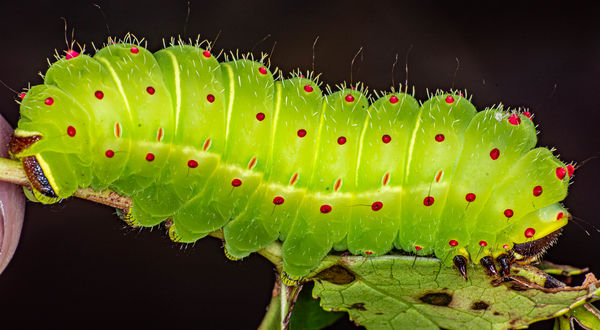Stabilizer for Canon 77D for Macro or close up stills
Jul 27, 2020 19:49:24 #
I have never used a stabilizer or gimbal. I won't be doing video. I have a tripod but don't always have time to set up. I'm pretty good at hand holding the camera but was wondering if a stabilizer would help with "fighting my body" in trying to stay still. Image stabilization on the camera is great but when you are trying pinpoint focus a tiny area even a fast shutter speed is not enough. If an camera stabilizer is a good idea to help be remain steady, then I would like some suggestions on what to look for that's small, portable and reasonable for an amateur photographer. Plus, I'm 71 and the muscles don't work the way the use to. Thanks, I appreciate any input.
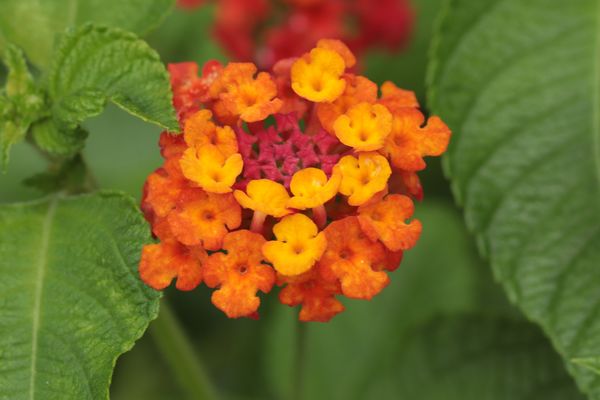
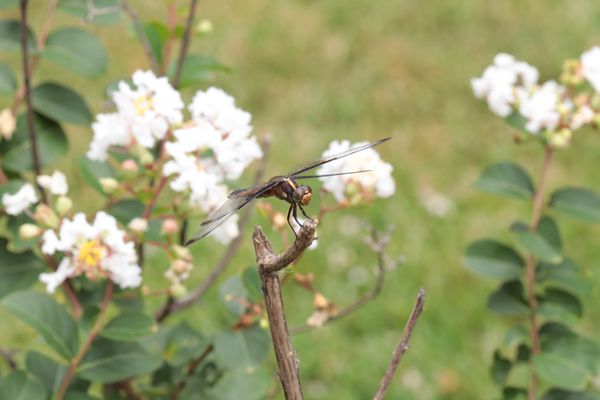
Jul 27, 2020 19:57:54 #
From a spry 54-year old, I've been using tripods for macro for the last 15-years of digital shooting. I consider a tripod critical, greatly enhanced by quick-release clamps and an L-plate on the camera body. Using a tripod lets you compose static shoots (your top flowers), including developing the exposure setting and the delicate and exact focus on minute details, especially via the camera's rear LCD live-view. Taking the weight of the camera off your hands helps to shoot slower for lower ISOs or smaller apertures, maximizing image quality.
How heavy and how expensive is a personal decision for selecting a tripod. What is critical is the ball head (and tripod overall) will 'lock' all your camera and lens combinations, both present and future. There's nothing more frustrating than when the camera moves after you've set-up a shot.
How heavy and how expensive is a personal decision for selecting a tripod. What is critical is the ball head (and tripod overall) will 'lock' all your camera and lens combinations, both present and future. There's nothing more frustrating than when the camera moves after you've set-up a shot.
Jul 27, 2020 20:01:02 #
LWW
Loc: Banana Republic of America
Other options are a monopod or a pistol grip which attaches to the tripod socket.
Jul 27, 2020 20:21:44 #
I have a Rangers tripod for travel with a ball head which works decent. It's not a fluid head. I probably should just mount the camera to the tripod and think of it as one unit and not be lazy. Thanks for your insight.
Jul 27, 2020 20:32:26 #
Old Timer
Loc: Greenfield, In.
I have found that a tripod or other stabilization is the best way to improve your pictures. I have taken picture on tripod and had near 100% success on focus. Not using a tripod about 10%. For macro as stated above or long distance is a must. I have tried shoot the moon hand held and even with tripod I use the timer or delayed setting. I do not understand some thinking they are steadier than a tripod or support. Even marksmen use support of some kind when possible. Ego probably, just to say hand held.
Jul 27, 2020 21:14:25 #
LWW wrote:
Other options are a monopod or a pistol grip which attaches to the tripod socket.
I use a pistol grip on both my monopod and tripod. I wouldn't be without them.
Jul 27, 2020 21:25:27 #
Ron Seher wrote:
. . . If an camera stabilizer is a good idea to help be remain steady, then I would like some suggestions on what to look for that's small, portable and reasonable for an amateur photographer. . .
. . . If an camera stabilizer is a good idea to help be remain steady, then I would like some suggestions on what to look for that's small, portable and reasonable for an amateur photographer. . .
Consider a bean bag or sand bag. Even a 2 pound bag of rice ( straight off the grocery shelf) will add mass to your camera setup. The more mass, the slower it accelerates when disturbed. That cuts down on various trembling and flinching affecting the exposure. Heavy and ugly but the principle is followed by target shooters. Price is right and worth a try. Works for some shots.
Steady-cams used by video photographers are gyroscopes in a box. They replace mass with a spinning gyro that resists sideways motion. You might find a used one that was made for an obsolete film camera.
Tripod replacements, which screw in to the tripod socket on camera or long lens, include chest pods, shoulder stocks, monopods, braced neckstraps or chest harnesses, and drop cords.
Personally I favor a chest pod. I am fortunate to have a Leitz table-top tripod with a tall ball head. When opened up fully I can rest the feet of the tripod on my upper chest, surrounding my collarbone. I want it above the center of my chest. which expands when I breathe. With this gadget partially unfolded it can serve as a shoulder stock. You can fabricate a chestpod from a small piece of plywood and some pipe attached to a tripod head or ball head. I’m not aware of any commercially made.
Shoulder stocks were once the ‘go to’ tool for photographers using long telephoto lenses at NFL events when tripods and monopods were banned. There was fear that a player might fall over a slow-moving photographer (weighed down by his tripod) should they go out the sideline. Novoflex made shoulder stocks integral parts of the focussing mechanism on their lenses. Their trigger action made for rapid action and the shoulder mount anchored the camera, much like a good stock on a rifle or shotgun stabilizes things.
There are some commercially made shoulder stocks, some people simply modify a commercial replacement rifle stock by inserting a long 1/4” bolt through the hole where the receiver of the rifle would go. These things look a little intimidating. It is hard to remember that this is not a real gun being aimed.
A similar idea is a simple chunk of 2 x 4 held in the shoulder like a gun stock. More elaborate homemade stocks can be made from 2 x6 or plywood, cut into curved shapes resembling half a gun stock, or a crossbow without the bow. Making your own allows you to customize the fit for best eye relief, but the tinkering can become a new hobby unto itself.
A monopod can be a collapsible set of telescopic tubing or a simple walking stick of hiking stave. Buy or make.
Simplest thing to try is to get a long dowel, wood closet rod or replacement mop handle from the hardware store. Cheapest is to pick up a fallen branch and trim the ends. Drill a 3/16” hole in the end and thread in a short 1/4” hanger bolt. A hanger bolt has wood threads at one end and machine threads at the other. Hardware stores have ‘em for under a dollar. Add a washer and nut and thread it onto the camera. Cut the stick so the viewfinder is at, or below, eyelevel. A brass washer will avoid scratching the cameras bottom plate, so will a piece of masking tape.
The principle with the monopod is that it reduces shaking. The bottom end is on the ground, eliminating shake, and the only movement is rotation or in an arc, with the monopod serving as the radius. A tripod head ( or ball head or gimbal) is not needed but some people like them as they give a little flexibility in composition.
While a monopod provides resistance to random movement using the force of compression, a drop string does the same by using the force of tension. Cheap, small, lightweight and easier to make than buy. A drip string is nothing more than a rope with a 1/4” eyebolt at one end. Screw that into the tripod socket, drop the rope on the ground and step on it. Pull taut. Some people tie a loop at the foot end and stick their foot into the loop so the rope doesn’t slip. Get paracord. It is available at craft stores and doesn’t stretch like cotton clothesline. Very strong stuff. When stretched it reduces some jitters, but it is not as effective as a rigid monopod.
I replaced my stock camera neckstrap with one made from 1/8” nylon cord with the intention that I could use that as a drop cord if needed. I have always had it there on the camera, but never used it for that purpose. Plenty of times I have used the cord with the tabletop tripod to lash my gear to a tree. Great when I wanted to join a group picture and a tree was handy but a regular tripod was not.
Completing the circle of camera supports: there are camera harness systems which allow you to brace the camera by pulling the camera away from where it is attached to your chest. A chest pod compares to a harness like a monopod compares to a drop string. In one case you brace the camera on the ground, in the other you brace it on your chest. In one case you push the camera on a solid mount, in the other you pull it against some resistance.
I’m sure there are many more options. These are what I’ve used or seen others use. Find what works for you.
Jul 27, 2020 22:28:09 #
If I remember correctly, imagemeister (forum member) designed and marketed a bodypod at one time for stabilization. You might shoot him a PM and ask if he still has them available. If I’m mistaken, apologies in advance...
Jul 27, 2020 22:35:56 #
Wow! Thanks for the all the suggestions. I never would have thought of many of those. I can see how useful some of your ideas could be in a pinch.
Jul 28, 2020 08:09:50 #
Macro being my niche, (and I'll be 71 soon) I seldom use any of my tripods, monopods, etc except indoors in studio conditions and of static subjects. I prefer additional lighting as the shorter flash duration stops all motion, be it mine or my subjects and it also allows for smaller apertures, thus increasing the shallow DOF in macro...
Jul 28, 2020 09:26:59 #
Ron Seher wrote:
I have never used a stabilizer or gimbal. I won't ... (show quote)
I don't notice motion, but what I see the a very shallow depth of focus. The top photo has a part of the leaf on the left in focus, and the fly head is the best but not good.
You have plenty of suggestions on tripods which is always a great help, but I think you need a better focus, and stop down some for more depth. JMHO
Jul 28, 2020 09:41:56 #
MrPhotog wrote:
Consider a bean bag or sand bag. Even a 2 pound ba... (show quote)
A good overview but as mentioned not totally complete. - https://www.uglyhedgehog.com/t-236741-1.html
https://www.uglyhedgehog.com/t-269999-1.html
Stabilization also helps with AF and compositional accuracy irregardless of using flash....
.
Jul 28, 2020 10:08:26 #
I don't like carrying a tripod on hiking trails, trying to reduce weight and gear. My walking stick has a monopod head, so that helps. But when low to the ground for flowers and such I carry some rubber bands and 3 sticks cut from thin fibergass driveway markers, each about 15 inches so they fit in my camera backpack, with the little rubber tips on. I wrap the rubber bands around the top of the sticks and use the claw of my left hand to hold them stiff in the correct spot to form a tripod, then rest my camera in my right hand on top of my left hand or arm. Set the camera for 2 second delay and breathe out.
Jul 28, 2020 13:40:09 #
amfoto1
Loc: San Jose, Calif. USA
Ron Seher wrote:
I have never used a stabilizer or gimbal. I won't ... (show quote)
Your best bet will always be to simply make the time to set up the tripod and use various shake reduction techniques such as remote shutter release, mirror lockup (or Live View), etc.
High optical magnification also magnifies any and all movement of lens and camera. Image stabilization of any sort can only do so much.
Shooting outdoors in reasonably good light, such as appears to be the case with your shots, you also might try a monopod for faster shooting situations.
Macro flash is another way to "freeze movement". You might experiment with it. This doesn't necessarily mean run out and buy an expensive macro flash. Personally I sometimes shoot macro and close-ups simply using a standard flash that's hand held, off to one side, attached to the camera via an off-camera shoe cord and diffused with a few layers of white gauze bandage over the flash head, held in place by a rubber band.
I use macro flash at times too. Those are fairly bulky and expensive, but can be the best choice for certain things. Personally I don't care for the "look" of ring lights for anything other than ultra high magnification. In my opinion, at lower magnifications a macro ring light can look too flat and "clinical". So I almost never use my ring light except with an ultra high magnification lens, at greater than 1:1 magnification. More often and for more typical, more modest magnification close-ups I use a macro twin light.... two separate, small flash heads that can be set to different output and positioned individually.
Camera stabilizing devices.... also called "gimbals"... are primarily intended for video work. Not still photography. The best and most effective ones tend to be rather bulky... though there are small ones being produced for use with tiny cameras and camera phones. I think you'd be very disappointed trying to use those for macro magnification, still photography. That really isn't their purpose.
The EXIF has been stripped off the example images you posted, so I can't tell tell what lens(es) you are using for close up/macro work. Maybe you already know, some macro lenses have built in image stabilization... To fit your camera those include: Canon EF 100mm f/2.8L IS USM, Canon EF-S 35mm f/2.8 IS STM, Tamron SP 90mm f/2.8 Di VC USD and Sigma 105mm f/2.8 EX DG OS HSM. Using one of those might help. However, you also shouldn't have too high expectations for this method of stabilization either. It can only do so much with higher magnification shots, which are very susceptible to camera shake. Personally I never bothered to "upgrade" to an image stabilized macro lens (though I use a number of other types of lenses with it). None of the lenses I use for close-up and macro work have it and my cameras don't have in-body image stabilization, either. I just use a tripod or monopod or at least find something to rest the camera upon whenever I can... keep shutter speeds reasonably fast and use various shake reduction techniques... use a flash when I can.
Canon MT-24EX Macro Twin Lite (100mm macro lens & DLSR)...

Above Twin Lite was used to make this image of an amarylis blossom at non-macro distance, with 100mm lens (tripod was used too)...

Canon MR-14EX Macro Ring Lite (65mm 1X-5X macro lens & DSLR)...

The above Ring Lite was used to make this photo of a tiny, freshly hatched garden snail at approx. 3X life size magnification (tripod was used too)....

Canon 580EX II standard flash set up for macro (100mm macro lens)...

The above was used to make this praying mantis photo, with 100mm macro lens (camera & lens were resting on an upside down 5 gallon paint bucket, flash was hand held)...

Some HAND HELD shots...
For the shot below of a bee on a poppy flower, I took about 75 shots with a manual focus, unstabilized 90mm macro lens hand held, to get a few well focused sharp ones with nice composition. Bright sun allowed me to keep shutter speeds reasonably fast.

This shot of a golden wood bee was done with an unstabilized, 180mm macro lens. However, I rested the camera and lens on the ground to prevent camera shake blur.

The small turtle below wasn't a particularly high magnification shot, but was shot indoors (strong window light). I pushed up the ISO (400) and used a large aperture (f/2.8) with my 100mm macro lens to hand hold a steady shot at 1/200 shutter speed.

The spider below was a quick grab shot (I was shooting a sporting event) with a fairly close focusing 300mm lens. If so happens, that is an image stabilized lens... though it's an older one where the IS is somewhat lower in effectiveness than some newer lenses. Using higher ISO (800) and fast shutter speed (1/1600) made reasonably easy to get a sharp shot. I did crop this image a little in post-processing.

These winter berries were photographed using an unstabilized, non-macro 24-70mm lens I was testing for it's closest focusing ability. It was shot in shade and a polarizing filter was used. With no flash and using the zoom at 63mm, I had to push my full frame 5D Mark II to ISO 3200 to get a 1/30 shutter speed. To get a sharp shot at that speed took several tries. I trashed the bad shots and only share the "keepers"!
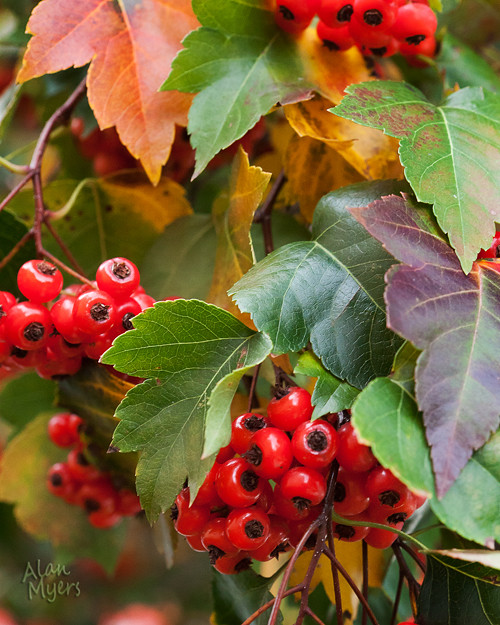
TRIPOD or MONOPOD SHOTS
These narcissus were in the shade, but I was still able to hand hold a shot with 100mm macro lens by using a fast enough shutter speed and a monopod.

The garden spider below was shot using an image stabilized 70-200mm non-macro lens, with an extension tube to make it focus closer. A flash was used for fill. I was shooting wildlife near a stream when I spotted this spider in its web. Didn't have a macro lens with me, but I always have extension tubes because they are so useful. Again, this was done using a tripod, even though the lens has IS and flash was used.

This orange canna was shot with a 500mm lens and film camera, all mounted on a tripod...

The following orchid was a carefully set up indoor shot, using a 100mm macro lens and tripod...

Fence lizards are very shy and quick to run to cover, so I used a 300mm lens with a 1.4X teleconverter allowed me to keep some distance. I also added an extension tube to allow the lens to focus closer than usual for a close-up of this small subject. No flash was used and everything was on a tripod, although the lens is image stabilized, allowing for a shutter speed of 1/100.
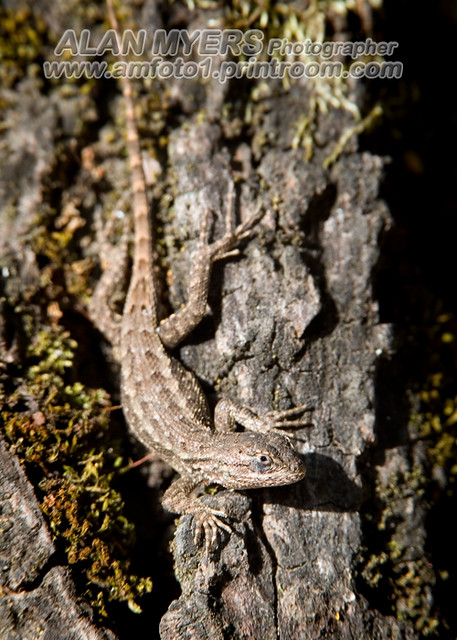
In the end, the best thing you can do is use your tripod more. A monopod, a flash and other things might help. Some shots will be hand-holdable... but the higher the magnification, the less that's possible. When in doubt, take more shots! Sometimes when I have to hand hold a shot and am really pushing my luck, I'll take a short burst of shots. Most might have shake blur problems... but maybe one or two will be sharp!
Hope this helps!
Jul 28, 2020 15:03:49 #
Just a note about ring lights... If your subject is reflective, then you can get reflections on your subject, otherwise no. Really, the same applies to most any light source....Here's an example of using a ring light with no spectral highlights...
If you want to reply, then register here. Registration is free and your account is created instantly, so you can post right away.






